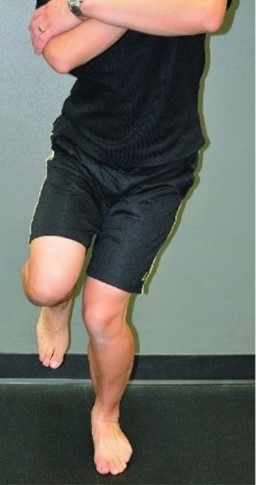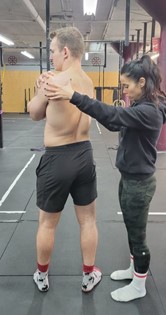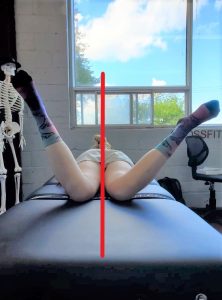
ACL, or anterior cruciate ligament, injuries are one of the most common, and perhaps most devastating sports injuries. Aside from the significant physical trauma, they lead to a lengthy interruption in sports participation and require an intensive course of rehab.
While we know that participation in sports comes with its inherent risks, when an injury is particularly prevalent in a sport, as is the case for ACL injuries, prevention becomes a compelling piece of the puzzle.
Prevention begins with identifying and addressing modifiable risk factors that can predispose an individual to injury.
Because the knee is an intermediate joint, the forces acting on it are impacted by the function and behavior of the hip and ankle. One element has more recently been explored is the impact of hip stiffness on frontal plane knee projection angle, a variable we often look at for ACL injury (1).
While neuromuscular factors like muscle activation and muscle recruitment patterns and technique play a role in optimal positioning, fundamental factors such as range of motion, certainly contribute to the biomechanical efficiency of the hip.
Hip stiffness has an important impact on movements such as deceleration, cutting and landing, which have long been identified as mechanisms for ACL injuries.
Let’s explore what to look for in the hip from that kinetic chain perspective.
Enjoyed this video? Make sure you subscribe to our YouTube channel!
ACL INJURIES – WHAT YOU NEED TO KNOW
While traumatic ACL injuries may result from contact with an opponent, non-contact mechanisms are about 80% more likely to cause an ACL injury (2). These non-contact injuries have been described as a combination of multiple plane forces acting collectively on the knee and involve the foot and ankle complex, the knee and the hip.
Perhaps the most recognized mechanism of injury is valgus loading such as when the individual takes off from the planted foot and internally rotates with the aim of suddenly changing direction:
Here is a video that shows this mechanism quite well: ACL Injury
Similar mechanisms have also been identified in landing tasks.
Globally, non-contact ACL injuries seem to be impacted by HOW forces are absorbed, distributed and transferred along the lower limb kinetic chain
Biomechanical inefficiency of this force distribution may contribute to increased ACL loading and eventually, failure.
The kinetic chain is composed of a series of interrelated sequentially activated segments, where movement of one segment affects the proximal and distal segments. Distally, the foot and ankle complex play an important role in absorbing and dissipating ground reaction forces as the foot impacts the ground. Appropriate ankle mobility is also important in affording us the capacity to absorb torsional forces such as those created when changing directions or decelerating.
As such, restoring or improving foot and ankle function is a crucial part of any rehab or prevention strategy. Make sure you read this article to learn how to restore specific ankle mobility for prevention.
Recently, more attention has been shifted proximally to the hip and the influence of its position on ACL injuries.
HIP STIFFNESS AND ACL INJURIES
The lower limb acts a little bit like a shock absorber. For example, as an individual takes a step, shifts weight towards one foot, decelerates or lands, impact forces (or load) are absorbed moving into foot pronation, ankle dorsiflexion, tibial internal rotation, and hip internal rotation. Note that this continues through the pelvis and midline via innominate rotation, SI joint nutation and sacral rotation.
In a dynamic environment like sports, while the foot and ankle absorb ground reaction forces distally, proximally, the hip assists in the absorption of reaction forces from the upper body.
In landing and deceleration, the hip joint plays an important role in absorbing trunk and pelvis rotation
Specifically, hip internal rotation is of particular interest from a rehab and prevention perspective.
A hip joint that is stiff or lacks appropriate internal rotation range of motion may cause the individual to shift their center of gravity laterally relative to the knee joint during deceleration and landing.
This places the hip in a position of adduction relative to the pelvis and forces the knee into a more valgus position (3).
WHAT DOES HIP STIFFNESS LOOK LIKE?
As mentioned earlier in the article, the concept of the kinetic chain relies on the biomechanical efficiency of a series of interrelated sequentially activated body segments where movement of one segment affects proximal and distal segments.
We know this is especially true of the knee, which is an intermediate joint depending on the efficiency of the ankle and hip to maintain its proper alignment.
Although this function dictates that we must consider the kinetic chain as a unit, efficient distribution of force along the kinetic chain depends on each of the different segments being capable of doing their job.
Fundamentally, if one joint is compromised, more force will be distributed to other joints
Many of you may be familiar with movement screening, which utilizes global and associative movements to observe how athletes move or use their body.
While we should avoid making direct assumptions with injury, movement screening may help us identify areas along the kinetic chain where movement is restricted, painful and/or unevenly distributed.
The Multisegmental Rotation Screen allows us to observe rotational mobility in the trunk, pelvis, hips, knees and feet as a contribution of all of these parts to the total motion. Assessing the quality of this total motion is a great place to start given what we have learned about rotation as an absorption mechanism in the previous section of this article.
When rotating to the left, as depicted in the picture above, the left foot will supinate and the right foot will pronate. The left hip will be in a position of internal rotation while the right hip will be in external rotation. The pelvis should rotate 50 degrees. When you assess this on both sides, you are looking at symmetry and effort. For example, you might find limited rotation to the left side when compared to the right side. If you did the test sitting and found that rotation was no longer restricted, you know something is going on in the ankles or hips and would explore that further in your assessment.
 With regards to hip rotation, a great way to assess the hip specifically for hip internal rotation range of motion is to place the individual in a prone position and allow the hip to fall into internal rotation as depicted in the image below:
With regards to hip rotation, a great way to assess the hip specifically for hip internal rotation range of motion is to place the individual in a prone position and allow the hip to fall into internal rotation as depicted in the image below:
A « normal » range for hip internal rotation is about 30-40 degrees, but really you are most concerned with side-to-side differences.
While you could assess rotation in a supine position with the hip and knee flexed to 90 degrees, this prone position allows you to observe whether the weight of the lower leg can bring the hip into internal rotation.
A hip that does not afford any, or very little, internal rotation in this position has more “stiffness”.
By the way, this is also a great way to assess for very low hip stiffness, but that will be the subject of another article.
MAKE SURE YOU WATCH THE MAIN VIDEO OF THIS ARTICLE FOR MORE ON THESE ASSESSMENTS AND OTHERS!
RESTORING FUNDAMENTALS
Numerous risk factors for ACL injury have been presented in the literature, so much so that the International Olympic Committee put forth a consensus statement highlighting 4 distinct areas of ACL risk factors: external, internal, hormonal, and biomechanical.
While we have little control over many of these risk factors, biomechanical risk factors are certainly modifiable and trainable.
Fundamentally, hip stiffness will impact how forces are distributed along the kinetic chain and can predispose an individual to ACL injury
Whether it be from a rehab, injury prevention or performance perspective, as therapists and trainers, our goal is to restore and improve movement capacity and potential by providing individuals with all of the resources they need to move efficiently.
Hip stiffness is one of those very important factors.
REFERENCES
- Bittencourt, N., Ocarino, J., Mendonça, L., Hewett, T., & Fonseca, S. (2012). Foot and Hip Contributions to High Frontal Plane Knee Projection Angle in Athletes: A Classification and Regression Tree Approach. Journal Of Orthopaedic & Sports Physical Therapy, 42(12), 996-1004. doi: 10.2519/jospt.2012.4041
- Krosshaug, T., Nakamae, A., Boden, B. P., Engebretsen, L., Smith, G., Slauterbeck, J. R., Hewett, T. E., & Bahr, R. (2007). Mechanisms of anterior cruciate ligament injury in basketball: video analysis of 39 cases. The American journal of sports medicine, 35(3), 359–367.
- Kianifar, R., Lee, A., Raina, S., & Kulic, D. (2017). Automated Assessment of Dynamic Knee Valgus and Risk of Knee Injury During the Single Leg Squat. IEEE journal of translational engineering in health and medicine, 5, 2100213. https://doi.org/10.1109/JTEHM.2017.2736559

Mai-Linh Dovan M.SC., CAT(C)
Certified Athletic Therapist
Founder of Rehab-U







… [Trackback]
[…] Read More here on that Topic: rehab-u.com/hip-stiffness-is-a-risk-factor-for-acl-injury/ […]
… [Trackback]
[…] Here you will find 85914 additional Information on that Topic: rehab-u.com/hip-stiffness-is-a-risk-factor-for-acl-injury/ […]
… [Trackback]
[…] Here you can find 10699 additional Information on that Topic: rehab-u.com/hip-stiffness-is-a-risk-factor-for-acl-injury/ […]
… [Trackback]
[…] Find More here to that Topic: rehab-u.com/hip-stiffness-is-a-risk-factor-for-acl-injury/ […]
… [Trackback]
[…] Read More here on that Topic: rehab-u.com/hip-stiffness-is-a-risk-factor-for-acl-injury/ […]
… [Trackback]
[…] There you can find 113 more Info to that Topic: rehab-u.com/hip-stiffness-is-a-risk-factor-for-acl-injury/ […]
… [Trackback]
[…] Find More to that Topic: rehab-u.com/hip-stiffness-is-a-risk-factor-for-acl-injury/ […]
… [Trackback]
[…] There you can find 58409 additional Information on that Topic: rehab-u.com/hip-stiffness-is-a-risk-factor-for-acl-injury/ […]
… [Trackback]
[…] There you can find 20857 more Information on that Topic: rehab-u.com/hip-stiffness-is-a-risk-factor-for-acl-injury/ […]
… [Trackback]
[…] Read More Info here to that Topic: rehab-u.com/hip-stiffness-is-a-risk-factor-for-acl-injury/ […]
… [Trackback]
[…] Here you can find 35679 additional Info to that Topic: rehab-u.com/hip-stiffness-is-a-risk-factor-for-acl-injury/ […]
… [Trackback]
[…] Read More to that Topic: rehab-u.com/hip-stiffness-is-a-risk-factor-for-acl-injury/ […]
… [Trackback]
[…] There you will find 38196 more Info to that Topic: rehab-u.com/hip-stiffness-is-a-risk-factor-for-acl-injury/ […]
… [Trackback]
[…] Find More Info here on that Topic: rehab-u.com/hip-stiffness-is-a-risk-factor-for-acl-injury/ […]
… [Trackback]
[…] Find More here to that Topic: rehab-u.com/hip-stiffness-is-a-risk-factor-for-acl-injury/ […]
… [Trackback]
[…] Find More to that Topic: rehab-u.com/hip-stiffness-is-a-risk-factor-for-acl-injury/ […]
… [Trackback]
[…] Find More on that Topic: rehab-u.com/hip-stiffness-is-a-risk-factor-for-acl-injury/ […]
… [Trackback]
[…] Read More to that Topic: rehab-u.com/hip-stiffness-is-a-risk-factor-for-acl-injury/ […]
… [Trackback]
[…] Find More to that Topic: rehab-u.com/hip-stiffness-is-a-risk-factor-for-acl-injury/ […]